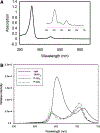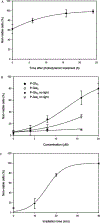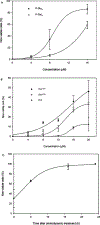Efficient synthesis and photodynamic activity of porphyrin-saccharide conjugates: targeting and incapacitating cancer cells
- PMID: 15323552
- PMCID: PMC6180334
- DOI: 10.1021/bi049272v
Efficient synthesis and photodynamic activity of porphyrin-saccharide conjugates: targeting and incapacitating cancer cells
Abstract
Since the role of saccharides in cell recognition, metabolism, and cell labeling is well-established, the conjugation of saccharides to drugs is an active area of research. Thus, one goal in the use of saccharide-drug conjugates is to impart a greater specificity toward a given cell type or other targets. Although widely used to treat some cancers and age related macular degeneration, the drugs used in photodynamic therapy (PDT) display poor chemical selectivity toward the intended targets, and uptake by cells most likely arises from passive, diffusional processes. Instead, the specific irradiation of the target tissues, and the formation of the toxic species in situ, are the primary factors that modulate the selectivity in the present mode of PDT. We report herein a two-step method to make nonhydrolyzable saccharide-porphyrin conjugates in high yields using a tetra(pentafluorophenyl)porphyrin and the thio derivative of the sugar. As a demonstration of their properties, the selective uptake (and/or binding) of these compounds to several cancer cell types was examined, followed by an investigation of their photodynamic properties. As expected, different malignant cell types take up one type of saccharide-porphyrin conjugate preferentially over others; for example, human breast cancer cells (MDA-MB-231) absorb a tetraglucose-porphyrin conjugate over the corresponding galactose derivative. Doseametric studies reveal that these saccharide-porphyrin conjugates exhibit varying PDT responses depending on drug concentration and irradiation energy. (1) Using 20 microM conjugate and greater irradiation energy induces cell death by necrosis. (2) When 10-20 microM conjugate and less irradiation energy are used, both necrosis and apoptosis are observed. (3) Using 10 microM and the least irradiation energy, a significant reduction in cell migration is observed, which indicates a reduction in aggressiveness of the cancer cells.
Figures










Similar articles
-
Porphyrin-bile acid conjugates: from saccharide recognition in the solution to the selective cancer cell fluorescence detection.Org Biomol Chem. 2008 May 7;6(9):1548-52. doi: 10.1039/b717528k. Epub 2008 Mar 12. Org Biomol Chem. 2008. PMID: 18421385
-
Carbon-1 versus Carbon-3 Linkage of d-Galactose to Porphyrins: Synthesis, Uptake, and Photodynamic Efficiency.Bioconjug Chem. 2018 Feb 21;29(2):306-315. doi: 10.1021/acs.bioconjchem.7b00636. Epub 2018 Jan 26. Bioconjug Chem. 2018. PMID: 29313666 Free PMC article.
-
Nuclear estrogen receptor targeted photodynamic therapy: selective uptake and killing of MCF-7 breast cancer cells by a C17alpha-alkynylestradiol-porphyrin conjugate.J Cell Biochem. 2006 Oct 15;99(3):966-77. doi: 10.1002/jcb.20955. J Cell Biochem. 2006. PMID: 16741968
-
Photodynamic therapy: shedding light on the biochemical pathways regulating porphyrin-mediated cell death.Histol Histopathol. 2001 Jan;16(1):309-17. doi: 10.14670/HH-16.309. Histol Histopathol. 2001. PMID: 11193207 Review.
-
Synthesis and Applications of Porphyrin-Biomacromolecule Conjugates.Front Chem. 2021 Nov 8;9:764137. doi: 10.3389/fchem.2021.764137. eCollection 2021. Front Chem. 2021. PMID: 34820357 Free PMC article. Review.
Cited by
-
Design and creativity in synthesis of multivalent neoglycoconjugates.Adv Carbohydr Chem Biochem. 2010;63:165-393. doi: 10.1016/S0065-2318(10)63006-5. Adv Carbohydr Chem Biochem. 2010. PMID: 20381707 Free PMC article. Review.
-
Photophysics of glycosylated derivatives of a chlorin, isobacteriochlorin and bacteriochlorin for photodynamic theragnostics: discovery of a two-photon-absorbing photosensitizer.Photochem Photobiol. 2014 Mar-Apr;90(2):419-30. doi: 10.1111/php.12179. Epub 2013 Nov 28. Photochem Photobiol. 2014. PMID: 24112086 Free PMC article.
-
Low concentrations of a non-hydrolysable tetra-S-glycosylated porphyrin and low light induces apoptosis in human breast cancer cells via stress of the endoplasmic reticulum.Photochem Photobiol Sci. 2008 Nov;7(11):1415-21. doi: 10.1039/b806536e. Epub 2008 Aug 18. Photochem Photobiol Sci. 2008. PMID: 18958330 Free PMC article.
-
Glycosylated Porphyrins, Phthalocyanines, and Other Porphyrinoids for Diagnostics and Therapeutics.Chem Rev. 2015 Sep 23;115(18):10261-306. doi: 10.1021/acs.chemrev.5b00244. Epub 2015 Aug 28. Chem Rev. 2015. PMID: 26317756 Free PMC article. Review.
-
Synthesis, Tumor Specificity, and Photosensitizing Efficacy of Erlotinib-Conjugated Chlorins and Bacteriochlorins: Identification of a Highly Effective Candidate for Photodynamic Therapy of Cancer.J Med Chem. 2021 Jan 14;64(1):741-767. doi: 10.1021/acs.jmedchem.0c01735. Epub 2021 Jan 5. J Med Chem. 2021. PMID: 33400524 Free PMC article.
References
-
- MacDonald IJ, and Dougherty TJ (2001) Basic principles of photodynamic therapy, J. Porphyrins Phthalocyanines 5, 105–129.
-
- Neurath AR, Strick N, and Debnath AK (1995) Structural requirements for and consequences of an antiviral porphyrin binding to the V3 loop of the human immunodeficiency virus (HIV-1) envelope glycoprotein gp120, J. Mol. Recog 8, 345–357. - PubMed
Publication types
MeSH terms
Substances
Grants and funding
LinkOut - more resources
Full Text Sources
Other Literature Sources
Medical
Research Materials
Miscellaneous

